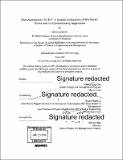| dc.contributor.advisor | Stuart Madnick. | en_US |
| dc.contributor.author | Gao, Olivia Qing | en_US |
| dc.contributor.other | Massachusetts Institute of Technology. Engineering Systems Division. | en_US |
| dc.date.accessioned | 2017-01-06T16:13:43Z | |
| dc.date.available | 2017-01-06T16:13:43Z | |
| dc.date.copyright | 2016 | en_US |
| dc.date.issued | 2016 | en_US |
| dc.identifier.uri | http://hdl.handle.net/1721.1/106247 | |
| dc.description | Thesis: S.M. in Engineering and Management, Massachusetts Institute of Technology, School of Engineering, System Design and Management Program, Engineering and Management Program, 2016. | en_US |
| dc.description | Cataloged from PDF version of thesis. | en_US |
| dc.description | Includes bibliographical references (pages 92-107). | en_US |
| dc.description.abstract | In the past two decades, the exponential growth of the modern Internet with the digitization of most human activities such as data gathering and storage have also fueled the growth of cybercrimes. In more recent years, the modern Internet is spreading into everyday life through the Internet of Things (IoT), which is further expanding the attack surface. Among all the IoT domains, the smart home, in particular, is poised to be one of the most exciting application areas of the IoT. However, behind the optimistic outlook, the shadow of an impending threat is also growing. Across the board, among the smart home device manufacturers, security is nearly non-existent or significantly downplayed. Consequently, the neglected, unresolved vulnerabilities in these devices widely expose their users and their family to cyberattacks. This thesis aims to illuminate the dynamics in the smart home market and their implications for IoT as a whole. First, it will review the past evolution of the IoT and the smart home along with current trends in enabling technologies. Next, through detailed examinations of four dynamic factors - i) macro pressures to innovate, 2) growing perils of cybercrimes, 3) vulnerabilities in the smart home, and 4) values at risk - the thesis seeks to elucidate the serious consequences of ignoring cybersecurity in the smart home system through causal loop diagramming. This thesis uses substantiated data from the past few years to justify its analyses. The thesis concludes that the smart home is an essential innovation that can help solve many urgent challenges facing our time, and securing the smart home devices is a key step towards building a safer and more secure IoT future as well as a future for the current generation and many generations to come. | en_US |
| dc.description.statementofresponsibility | by Olivia Qing Gao. | en_US |
| dc.format.extent | 107 pages | en_US |
| dc.language.iso | eng | en_US |
| dc.publisher | Massachusetts Institute of Technology | en_US |
| dc.rights | M.I.T. theses are protected by copyright. They may be viewed from this source for any purpose, but reproduction or distribution in any format is prohibited without written permission. See provided URL for inquiries about permission. | en_US |
| dc.rights.uri | http://dspace.mit.edu/handle/1721.1/7582 | en_US |
| dc.subject | Engineering and Management Program. | en_US |
| dc.subject | System Design and Management Program. | en_US |
| dc.subject | Engineering Systems Division. | en_US |
| dc.title | Risk Assessment for IoT : a system evaluation of the smart home and its cybersecurity imperative | en_US |
| dc.type | Thesis | en_US |
| dc.description.degree | S.M. in Engineering and Management | en_US |
| dc.contributor.department | Massachusetts Institute of Technology. Engineering and Management Program | en_US |
| dc.contributor.department | System Design and Management Program. | en_US |
| dc.identifier.oclc | 961922954 | en_US |

